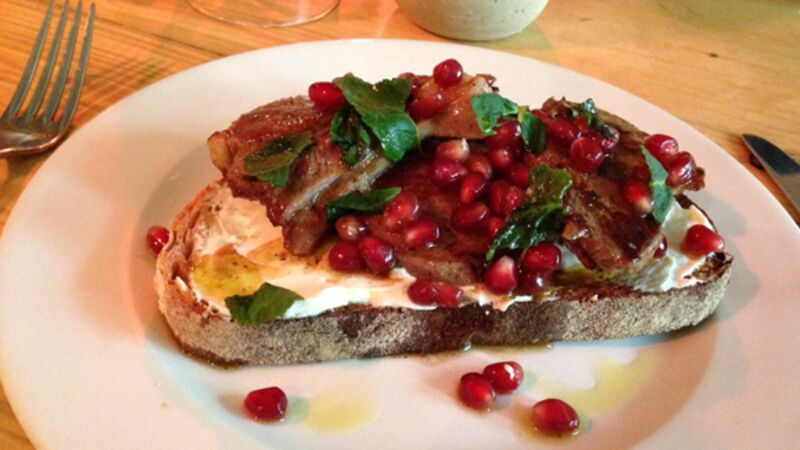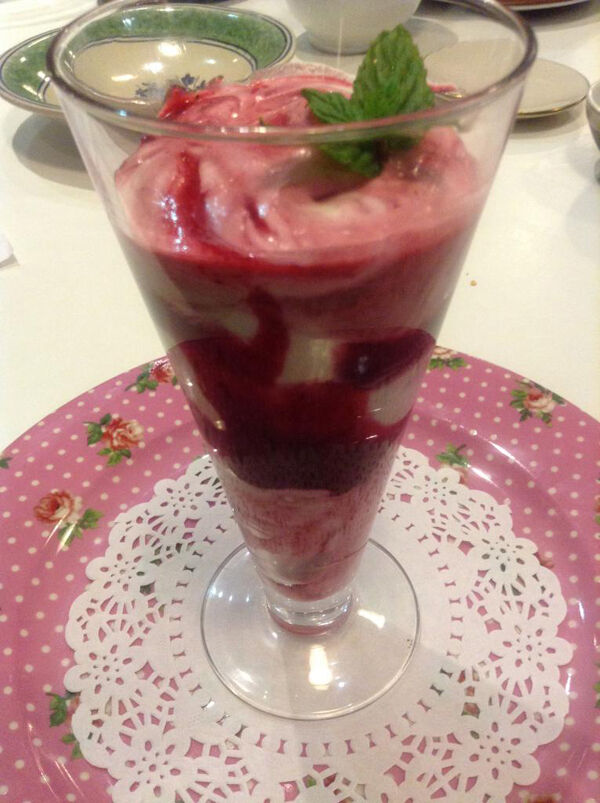Chargrilled Achill Mountain Lamb with Labneh, Pomegranate and Fresh Mint Leaves

The answer is it’s getting more perplexing now that multinational food companies have put their considerable energy and might into cleaning up labels so they sound more natural and less scary to the average consumer — a major exercise to quell our fears about the composition of products.
Food manufactures and processors are well aware that people are reassured by familiar sounding ingredients. So terms like natural, authentic, preservative and additive-free are proliferating on labels.
US Whole Foods Market chain was one of the first retailers to act. When they drew up an “unacceptable ingredients for food” list in July it sent shock waves through the global food industry.
At present the list includes more than 80 additives. Joanna Blythman’s book Swallow This: Serving up the Food Industry’s Darkest Secrets has many illuminating chapters on the subject all of us need to read.
Here in Ireland the Food Safety Authority of Ireland (FSAI) have responded to the concerns of the artisan food sector.
Guidelines were drawn up following a public consultation carried out by a working group with FSAI, the Artisan Food Forum, Food and Drink industry Ireland and the Taste Council and the Consumers Association of Ireland.
Food manufacturers will be given marketing terms to comply with the guidelines. If you feel that a label or marketing is misleading contact the FSAI at 1890-336677 or through the website www.fsai.ie
Artisan/Artisanal
The terms ‘artisan’ or ‘artisanal’ indicates that:
1) The food is made in limited quantities by skilled craftspeople.
2) The processing method is not fully mechanised and follows a traditional method.
3) The food is made in a micro-enterprise at a single location. The characteristic ingredient(s) used in the food are grown or produced locally, where seasonally available and practical.
Farmhouse
1. The food is made in a single location on a farm.
2. The food is made by a micro-enterprise.
3. The characteristic ingredient(s) used in the food are grown or produced locally.
Traditional
1. The food is made to an authentic recipe which can be proved to have existed without significant modification for at least 30 years and/or
2. the food has been made using a method of preparation that has: existed for more than 30 years, although automation and mechanisation of these methods is sometimes acceptable.
Natural
This word gives the impression that the food is wholesome and the food is formed by nature and is not significantly interfered with by man
Ireland is the first country in Europe to introduce such guidelines. Companies will be given 18 months to bring their labelling into compliance with the new guidelines
For further information see www.fsai.ie.
Slice the lamb. Heat a frying pan or grill pan. Season the meat with salt and freshly ground black pepper and drizzle with extra virgin olive oil. Cook until well seared on both sides.
Chargrill the bread, spread a generous layer of well-seasoned labneh on top.
Cover with slices of the warm lamb and a sprinkling of pomegranate seeds.
A little shredded mint, a drizzle of extra virgin olive oil and a few flakes of sea salt complete the feast.

This is one of those recipes that somehow is much greater than the sum of its parts.
Three simple ingredients produce a rich and luscious result. We are enjoying fresh raspberries from Rose Cottage in Co Laois.
Lay the raspberries in a single layer on a dish. Sprinkle on the sugar and allow to macerate for one hour.
If you are using frozen berries this should be long enough for them to defrost.
Purée the fruit in a liquidiser or blender then pass through a nylon sieve to remove the seeds.
Gently fold in the whipped cream – go lightly if you want to create a ‘swirly’ effect. The fool is now ready to be served or can be chilled for serving later. Serve with shortbread biscuits.
This is quick and easy to assemble and a good result is dependent on really fresh ricotta and very ripe cherries.
Remove the stones from the cherries and smash slightly. Sweeten them to taste with some of the caster sugar.
Allow to sit and macerate for at least 30 minutes to draw some of the juices out of the cherries and for the sugar to dissolve.
Divide the cheese between four plates and sweeten lightly with a sprinkling of caster sugar.
Scatter the cherries over and around the cheese. Drizzle on the olive oil and cream and any juice remaining from the cherries. Finally zest the lemon over each serving and serve immediately.
Mackerel has been pretty scarce enough this year but if you can get a few spanking fresh fish try this delicious combination of Rory O Connell’s.
Beetroot and horseradish are obvious combinations with this oily fish, the eggs add a little richness. This salad can be served as a starter or a main course.
Place the beetroot in a saucepan they fit snugly into. Season with a good pinch of salt and sugar. Cover with cold water and bring to a simmer. Cover and simmer until the beetroot are cooked.
The length of cooking time of the beets is determined by the size, age and freshness of the vegetable. They will take a minimum of 30 minutes and up to two hours to cook.
Any that take longer than that to cook tend to be either too big or too old and can be woody and faded when peeled. If the water evaporates during the cooking, top it up with fresh water.
Check to see if the beetroot are cooked by lifting one out of the saucepan and rubbing the skin. If the skin rubs off with no resistance, they are cooked.
If not, replace in the saucepan and cook for longer. When cooked, remove and allow to cool slightly.
I like to dress them while still warm. Mix the olive oil, honey and balsamic vinegar and season with salt and pepper. Peel the beetroot and slice in 1cm (½-inch) slices or cut into sections. Toss in the dressing, taste and correct seasoning.
Heat a heavy frying pan until hot but not quite smoking and glaze the bottom of the pan with a little olive oil.
Dip the mackerel fillets in seasoned flour and shake off the excess. Place the fish, skin side down in the hot oil and cook until a rich golden colour is achieved. Turn and cook on the other side.
While the fish are cooking, divide the greens between four, large hot plates. Drizzle with a little olive oil and season with salt and pepper.
Place the beetroot and their dressing on the greens and then divide the egg quarters between the plates.
Drizzle each plate with a dessertspoon of horseradish mayonnaise, particularly over the eggs and the beetroot. Place the cooked fish, straight from the pan on top of the salads. Sprinkle with chopped chives and serve immediately.
A garden workshop for your diary: On Monday, August 17, our head gardener, Susan Turner will teach a day-long course, Autumn Harvest and Winter Crops, to provide you with the necessary skills to grow organically.
She’ll talk about harvesting, winter soil management, planning for next year and selecting varieties for winter crops. Coffee on arrival and a delicious light lunch are included. Visit www.cookingisfun.ie
Exciting news for Jane Grigson’s many fans of which I certainly am one. The Best of Jane Grigson The Enjoyment of Food has recently been republished to coincide with the 25th year anniversary of her untimely death.
The book is organised into regional cuisines, including the Americas, the Mediterranean, and the Europeans. The recipes are varied from simple weekday dinner to celebratory feasts. Published by Grub Street Publishers.
Meadowsweet is flowering in all the hedgerows at the moment, use it to flavour syrups for lemonade, ice-creams and pannacotta.
Do you have a farmers market in your area? If you act fast and do your research, funding is available for community projects in rural areas. Proposals must be submitted by August 14. Check out www.agriculture.gov.ie/cedra/localfoodmarkets/ for further information














